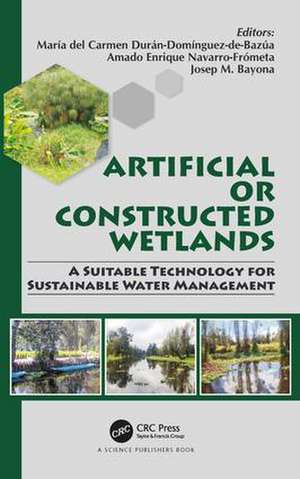Artificial or Constructed Wetlands: A Suitable Technology for Sustainable Water Management
Editat de María del Carmen Durán-Domínguez-de-Bazúa, Amado Enrique Navarro-Frómeta, Josep M. Bayonaen Limba Engleză Hardback – 15 iun 2018
| Toate formatele și edițiile | Preț | Express |
|---|---|---|
| Paperback (1) | 442.50 lei 6-8 săpt. | |
| CRC Press – 31 mar 2021 | 442.50 lei 6-8 săpt. | |
| Hardback (1) | 1181.73 lei 6-8 săpt. | |
| CRC Press – 15 iun 2018 | 1181.73 lei 6-8 săpt. |
Preț: 1181.73 lei
Preț vechi: 1592.62 lei
-26% Nou
Puncte Express: 1773
Preț estimativ în valută:
226.12€ • 236.72$ • 187.10£
226.12€ • 236.72$ • 187.10£
Carte tipărită la comandă
Livrare economică 07-21 aprilie
Preluare comenzi: 021 569.72.76
Specificații
ISBN-13: 9781138739185
ISBN-10: 1138739189
Pagini: 428
Ilustrații: 58 Tables, black and white; 4 Illustrations, color; 72 Illustrations, black and white
Dimensiuni: 156 x 234 x 30 mm
Greutate: 0.45 kg
Ediția:1
Editura: CRC Press
Colecția CRC Press
ISBN-10: 1138739189
Pagini: 428
Ilustrații: 58 Tables, black and white; 4 Illustrations, color; 72 Illustrations, black and white
Dimensiuni: 156 x 234 x 30 mm
Greutate: 0.45 kg
Ediția:1
Editura: CRC Press
Colecția CRC Press
Cuprins
Xochimilco, Mexico, a Natural Wetland or an Artificial One? Rhizospheric Processes for Water Treatment - Background Principles, Existing Technology and Future Use. Use of Artificial Wetlands as Degradation Systems of Recalcitrant Contaminants and Transformers of Energy to Electricity. Constructed Wetlands for the Tertiary Treatment of Municipal Wastewaters: Case Studies in Mexico at Mesocosm Level. Effect of Support Media on Heavy Metals Removal in Constructed Wetlands Inoculated with Metallotolerant Strains. Full-Scale Applications of Constructed Wetlands in Africa. Application of a Multi-function Constructed Wetland for Stream Water Quality Improvement and Ecosystem Protection: A Case Study in Kaohsiung City, Taiwan. Constructed Wetlands Technology in Cuba: Research Experiences. Greenhouse Gas Emissions and Treatment Performance in Constructed Wetlands with Ornamental Plants: Case Studies in Veracruz, Mexico. Treatment of Wastewater from Livestock Activities with Artificial or Constructed Wetland. REAGRITECH Project: Regeneration and Reuse of Runoff and Drainage Water from Agriculture by Treatment Wetlands. Bioremediation of Shrimp Aquaculture Effluents: Artificial Wetlands Potential Use. Fate of Contaminants of Emerging Concern in Constructed Wetlands. Electrochemically Assisted Artificial Wetlands: Generating Electricity from Wastewater Treatment. Predictive Models to Assess the Uptake of Organic Microcontaminants and Antibiotic Resistant Bacteria and Genes by Crops. The Role of Macrophytes in the Removal of Organic Micropollutants by Constructed Wetlands. Influence of Design and Operation Parameters in the Organic Load and Nutrient Removal in Constructed Wetlands. Design and Construction of an Artificial Subsuperficial Wetland of Double Cell. An Experience in Palmillas, Querétaro Mexico. Strategies of the Constructed Wetlands Operation under the Perspective of the Global Change Scenario. Uptake and Detoxification of Organic Micropollutants by Macrophytes in Constructed Wetlands
Notă biografică
María del Carmen Durán-Domínguez-de-Bazúa, Amado Enrique Navarro-Frómeta, Josep M. Bayona
Descriere
As plants and microorganisms are a fundamental part of the correct functioning of these systems, their contribution to the degradation of the organic matter and to the removal and transformation of the pollutant compounds present in the wastewaters, including those of emerging concern, is a highlight of this book.
